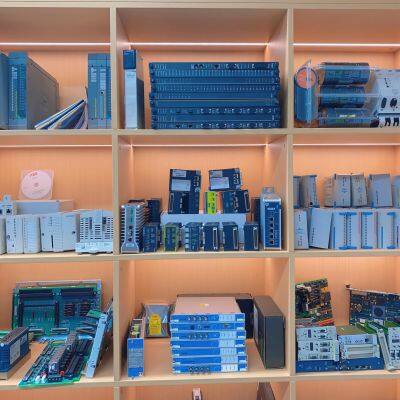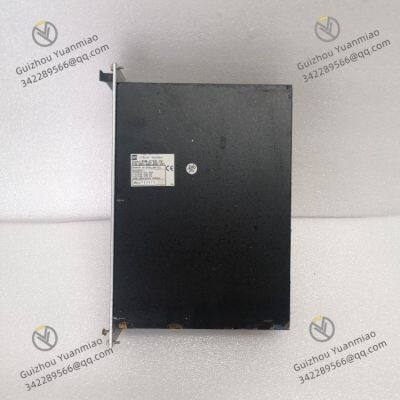Product Description
VM600 RPS6U 200-582-200-011 is a high-performance rack-mounted power module meticulously developed by Vibro-Meter for industrial equipment condition monitoring systems, and it is an important part of the VM600 series products. With its excellent power output capability, comprehensive protection mechanisms, and outstanding system compatibility, it lays a solid foundation for the stable operation of the entire monitoring system, plays an indispensable role in various industrial scenarios, and helps enterprises achieve efficient and reliable monitoring and management of equipment.

I. Core Functions
(1) Stable and Efficient Power Output
Multi-channel precise power supply: This power module is equipped with 6 independent output channels, each of which can output a stable DC voltage. Among them, the common output voltages are +5V DC and ±12V DC, which can simultaneously provide power support for many monitoring modules in the VM600 system (such as IOC4T input/output control module, MPC4 data processing module, etc.) and various sensors. In the monitoring system of large motor units, different channels can respectively supply power to the vibration sensors at the motor bearings, the speed sensors at the shaft ends, and the modules responsible for data processing, ensuring that all components work together under stable power and guaranteeing the accuracy and stability of the monitoring system.
Wide range of input adaptation: It supports multiple types of input power supplies, including AC 115/230V AC or DC 24V DC, 110V DC, 220V DC and other wide-range inputs. This enables it to easily adapt to power supplies of different types in different regions. In international projects or complex power supply environments, it can be directly connected to the local power grid without additional power conversion equipment, greatly improving the versatility and applicability of the module.
Efficient power conversion: It adopts advanced power conversion technology, with a power conversion efficiency of over 90%. This not only can effectively reduce energy loss and lower the operating costs of enterprises, but also reduce the heat generation of the module itself during operation. In monitoring systems that run continuously for a long time, lower heat generation helps to extend the service life of the equipment, reduce the requirements for the cooling system, and improve the overall stability of the system.
(2) Comprehensive Power Protection
Overvoltage protection: It has a built-in precision overvoltage protection circuit. When the output voltage exceeds the preset safety threshold, the module will quickly activate the protection mechanism in a very short time and automatically cut off the output circuit. This function can effectively prevent excessive voltage from causing irreversible damage to precision equipment such as monitoring modules and sensors that are supplied with power, avoid equipment failures and data loss caused by voltage abnormalities, and provide a solid guarantee for the stable operation of the monitoring system.
Overcurrent protection: Each output channel is equipped with an independent overcurrent protection circuit. Once the output current of a certain channel exceeds the rated value, the channel will immediately take current limiting measures or, if necessary, turn off the output to prevent module damage caused by load short circuits, overloads, etc. For example, when a short circuit occurs due to a fault inside a sensor or monitoring module, the overcurrent protection can promptly cut off the power supply of the faulty channel, avoid the spread of the fault, and ensure that other channels and some functions of the entire monitoring system can still operate normally.
Short-circuit and overheating protection: It has a complete short-circuit protection function. When a short circuit occurs at the output end, the module will immediately stop outputting, and can automatically resume normal operation after the short-circuit fault is eliminated. At the same time, the module integrates a high-precision temperature sensor to monitor its own temperature in real time. When the temperature exceeds the safety threshold, the overheating protection mechanism is activated, and the module will automatically reduce the output power or turn off the output to prevent damage to internal components due to overheating. In high-temperature industrial environments (such as steel plants, cement plants) or places with poor heat dissipation conditions, the overheating protection function can ensure the safe and stable operation of the module.
(3) System Collaboration and Intelligent Monitoring
Seamless integration with VM600 system: It adopts a standardized interface design, which can realize seamless communication and collaborative work with other modules in the VM600 system. The module can transmit its real-time working status, including key information such as output voltage, current, and temperature, to the central controller of the system in real time through a specific communication protocol. With the help of the central controller, operators can monitor the operating status of the RPS6U 200-582-200-011 module in real time, promptly detect power abnormalities, and provide strong support for system maintenance and management.
Fault alarm output: When the module has faults such as overvoltage, overcurrent, or overheating, it will quickly output a fault signal through a dedicated alarm interface. This signal can directly trigger an external sound and light alarm device to attract the attention of on-site personnel; it can also be uploaded to a remote monitoring system to facilitate timely response by operation and maintenance personnel. In large industrial monitoring centers, rapid fault alarms can greatly shorten the monitoring interruption time caused by power failures and reduce production losses.
Redundancy backup support: It supports redundant configuration mode. In the VM600 system rack (such as VM600 ABE04X system rack), two RPS6U power modules can be installed at the same time. When one of the modules fails, the other module can automatically take over all its work to ensure the continuity of power supply. In scenarios with extremely high requirements for the reliability of monitoring systems, such as nuclear power plants and chemical production, the redundancy backup function can significantly improve the fault tolerance of the system, ensure the uninterrupted progress of equipment monitoring work, and effectively reduce the risk of safety accidents caused by power failures.

II. Hardware Characteristics
(1) Industrial-grade Rugged Construction
Stable operation in a wide temperature range: High-quality industrial-grade components are selected, and a specially optimized heat dissipation structure design is adopted, enabling it to work stably in an extremely wide temperature range, with the operating temperature range being -25℃ to +70℃. Whether in cold northern industrial areas or hot southern metallurgical workshops, this module can operate normally, continuously providing stable power for the monitoring system, without being affected by extreme ambient temperatures.
Strong anti-electromagnetic interference: It has excellent electromagnetic compatibility. Through multi-layer shielding and efficient filtering design, it can effectively resist complex electromagnetic interference, radio frequency interference, etc. in industrial sites. In environments with a large number of strong interference sources such as frequency converters, electric welders, and large motors, it can ensure the stable and pure output voltage, prevent interference signals from entering monitoring equipment through power lines, and avoid affecting the normal operation of the equipment and the accuracy of monitoring data.
Dust and moisture resistance: The protection level reaches IP20, which can effectively block dust and water vapor from entering the module, making it suitable for most conventional industrial environments. It can operate stably for a long time in dusty cement plants, humid paper mills and other places, reduce power failures caused by environmental factors, and extend the service life of the equipment.
(2) Compact Design and Convenient Installation
Modular compact structure: It adopts a modular design concept, with an overall compact structure. Its size is adapted to the standard 19-inch rack of the VM600 series (with a standard height of 6U), and it can be easily installed inside the rack, greatly saving installation space. In equipment control cabinets with limited space, its compact design can be flexibly installed with other monitoring modules, improving space utilization and making the equipment layout more reasonable.
Standardized installation methods: It provides two standardized installation methods: rail mounting and rack mounting, and the installation process is simple and fast. Technicians can quickly complete the fixing and wiring of the module according to the actual on-site conditions and installation requirements. During the new installation or upgrade and transformation of the monitoring system, the convenient installation method can significantly shorten the construction period, reduce installation costs, and improve work efficiency.
Easy maintenance design: The output interfaces of the module are reasonably arranged and clearly marked, facilitating maintenance personnel to perform wiring operations; at the same time, it is equipped with status indicators to visually display the working status of the module. When a fault occurs, maintenance personnel can quickly judge the type and location of the fault through the status of the indicators, greatly shortening the fault troubleshooting time, improving maintenance efficiency, and ensuring the normal operation time of the monitoring system.

III. Application Fields
(1) Energy and Power Industry
Power generation equipment monitoring system: In thermal power plants and hydropower plants, it provides power support for the monitoring systems of key power generation equipment such as steam turbines and generators. It ensures the stable operation of vibration monitoring modules, speed sensors, data acquisition units and other equipment, collects equipment operation data in real time, timely detects potential faults such as rotor imbalance and bearing wear, guarantees the safe and efficient operation of power generation equipment, reduces downtime caused by equipment failures, and improves power generation efficiency.
Transmission and distribution equipment monitoring: It supplies power to transformer monitoring systems and high-voltage switch monitoring equipment in substations. In harsh environments such as field substations with complex power supply conditions, the RPS6U 200-582-200-011 module, with its characteristics of wide temperature operation and strong anti-interference, can ensure that monitoring equipment stably obtains power, real-time monitors parameters such as oil temperature, winding temperature, and vibration of transformers, as well as the opening and closing status and contact temperature of high-voltage switches, ensuring the safe and reliable operation of transmission and distribution equipment and the stability and continuity of power transmission.
(2) Petrochemical Industry
Refining and chemical equipment monitoring system: In the process of petroleum refining and chemical production, it supplies power to the monitoring systems of key refining and chemical equipment such as compressors, reaction kettles, and pumps. It provides stable power for vibration sensors, temperature sensors, pressure sensors, and data processing modules, and real-time monitors the operating status of the equipment. When the equipment has abnormal vibration, excessive temperature, pressure fluctuations, etc., the monitoring system can issue early warnings in a timely manner, helping operators take measures in advance to prevent production accidents caused by equipment failures and ensuring the continuity and safety of chemical production.
Pipeline monitoring system: It provides continuous and stable power for equipment such as leakage monitoring, pressure monitoring, and temperature monitoring of petrochemical pipelines. Through real-time monitoring of pipeline operation parameters, it timely detects hidden dangers such as pipeline leakage, corrosion, and blockage, ensures the safe transportation of petrochemical pipelines, and reduces the risk of environmental pollution and economic losses caused by pipeline failures.
(3) Manufacturing Industry
Production line equipment monitoring: In the automated production line monitoring systems of industries such as automobile manufacturing and mechanical processing, it supplies power to various sensors (such as vibration sensors, position sensors, proximity sensors) and data acquisition modules. It real-time monitors the operating status of robots, conveying equipment, processing equipment, etc. on the production line, timely detects equipment failures and abnormalities, and through fault early warning and rapid response, improves the operating efficiency and product quality of the production line, and reduces economic losses caused by production interruptions.
Large machine tool monitoring: It supplies power to the monitoring systems for vibration, temperature, displacement, etc. of large machine tools such as CNC machine tools and machining centers. It ensures that monitoring equipment can continuously and stably collect machine tool operation data, helps operators timely understand the working status of machine tools, adjust processing parameters, prevents problems such as reduced processing accuracy and product scrapping caused by equipment failures, extends the service life of machine tools, and improves production efficiency.
Vibro-meter 200-595-031-111 VM600 CPUM Input/Output Communications Network Card
VIBRO-METER 200-595-100-014 200-595-072-122 VM600 CPUM CPU Board
VIBRO-METER 600-003 620-001-001-116 VM600 XMV16 Regulator Module
VIBRO-METER 620-002-000-113 620-003-111-112 VM600 XIO16T Communication Interface Card
Vibro-meter MPC4 200-510-078-115 Machinery Protection Card
Vibro-meter VM600 MPC4 200-510-064-034 200-610-100-034 Machinery Protection Card


GE IS420YDIAS1B Discrete Output I/O Pack
GE IS420YAICS1B Analog I/O Pack
GE IS420YDOAS1B Discrete Output I/O Pack
GE IS410STCIS2A Compact Contact Input Terminal Board
GE IS410STAIS2A Analog I/O Module
GE IS410SRLYS2A Simplex Terminal Board
GE IS400STCIS2AFF Terminal Board
GE IS400STAIS2AED Simplex Terminal Board
GE IS400SRLYS2ABB Simplex Terminal Board
GE IS200JPDMG1ACC Power Distribution Card
GE IS420UCSCH1A-F-V0.1-A Controller
GE UCSC H1 IS420UCSCH1A-B Controller
GE PRG-MODEM Regulator Module
GE WES5162 Frame Rack
Allen-Bradley 1756-2WS Weigh Scale Module
RELIANCE ELECTRIC S-D4012 PLC Controller
LAM 810-800082-043 VME BREAKOUT BOARD
Allen-Bradley 1756-A7 Seven (7) Slot Chassis
Allen-Bradley 1756-A13 Seven (13) Slot Chassis
Allen-Bradley 1756-CN2R ControlNet Communication Module
Allen-Bradley 1756-CN2RXT Controlnet Redundant Interface Module
Allen-Bradley 1756-CNB ControlNet Interface Module
Allen-Bradley 1756-DHRIO ControlLogix DH Plus/RIO Comms Module
Allen-Bradley 1756-DNB DeviceNet Scanner Module
 yezi
Hi there! Welcome to my shop. Let me know if you have any questions.
yezi
Hi there! Welcome to my shop. Let me know if you have any questions.





